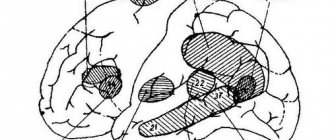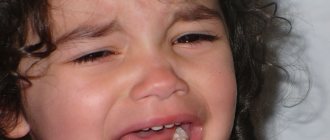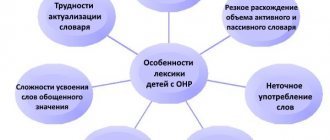Dysarthria is a severe speech disorder, accompanied by a disorder of articulation, phonation, speech breathing, tempo-rhythmic organization and intonation coloring of speech, as a result of which speech loses its articulation and intelligibility. Among children, the prevalence of dysarthria is 3-6%, but in recent years there has been a pronounced upward trend in this speech pathology. In speech therapy, dysarthria is one of the three most common forms of oral speech disorders, second only to dyslalia in frequency and ahead of alalia. Since the pathogenesis of dysarthria is based on organic lesions of the central and peripheral nervous system, this speech disorder is also studied by specialists in the field of neurology and psychiatry.
Causes of dysarthria
Most often (in 65-85% of cases) dysarthria accompanies cerebral palsy and has the same causes. In this case, organic damage to the central nervous system occurs in the prenatal, birth or early periods of child development (usually up to 2 years). The most common perinatal factors of dysarthria are toxicosis of pregnancy, fetal hypoxia, Rhesus conflict, chronic somatic diseases of the mother, pathological course of labor, birth injuries, at birth, kernicterus of newborns, prematurity, etc. The severity of dysarthria is closely related to the severity of motor disorders in cerebral palsy : Thus, with double hemiplegia, dysarthria or anarthria is detected in almost all children.
In early childhood, damage to the central nervous system and dysarthria in a child can develop after suffering neuroinfections (meningitis, encephalitis), purulent otitis media, hydrocephalus, traumatic brain injury, severe intoxication.
The occurrence of dysarthria in adults is usually associated with a stroke, head injury, neurosurgery, and brain tumors. Dysarthria can also occur in patients with multiple sclerosis, amyotrophic lateral sclerosis, syringobulbia, Parkinson's disease, myotonia, myasthenia, cerebral atherosclerosis, neurosyphilis, oligophrenia.
Classification of dysarthria
The neurological classification of dysarthria is based on the principle of localization and a syndromic approach. Taking into account the localization of damage to the speech-motor apparatus, the following are distinguished:
- bulbar dysarthria associated with damage to the nuclei of the cranial nerves (glossopharyngeal, sublingual, vagus, sometimes facial, trigeminal) in the medulla oblongata
- pseudobulbar dysarthria associated with damage to the corticonuclear pathways
- extrapyramidal (subcortical) dysarthria associated with damage to the subcortical nuclei of the brain
- cerebellar dysarthria associated with damage to the cerebellum and its pathways
- cortical dysarthria associated with focal lesions of the cerebral cortex.
Depending on the leading clinical syndrome, cerebral palsy may include spastic-rigid, spastic-paretic, spastic-hyperkinetic, spastic-atactic, ataxic-hyperkinetic dysarthria.
Speech therapy classification is based on the principle of speech intelligibility for others and includes 4 degrees of severity of dysarthria:
1st degree (erased dysarthria) – defects in sound pronunciation can only be identified by a speech therapist during a special examination.
Grade 2 defects in sound pronunciation are noticeable to others, but overall speech remains understandable.
3rd degree - understanding of the speech of a patient with dysarthria is available only to those close to him and partially to strangers.
4th degree speech is absent or incomprehensible even to the closest people (anarthria).
Symptoms of dysarthria
The speech of patients with dysarthria is slurred, unclear, and incomprehensible (“porridge in the mouth”), which is due to insufficient innervation of the muscles of the lips, tongue, soft palate, vocal folds, larynx, and respiratory muscles. Therefore, with dysarthria, a whole complex of speech and non-speech disorders develops, which constitute the essence of the defect.
Impaired articulatory motor skills in patients with dysarthria may manifest as spasticity, hypotonia, or dystonia of the articulatory muscles. Muscle spasticity is accompanied by constant increased tone and tension in the muscles of the lips, tongue, face, and neck; tightly closed lips, limiting articulatory movements. With muscle hypotonia, the tongue is flaccid and lies motionless on the floor of the mouth; the lips do not close, the mouth is half open, hypersalivation (salivation) is pronounced; Due to paresis of the soft palate, a nasal tone of voice appears (nasalization). In the case of dysarthria occurring with muscular dystonia, when attempting to speak, muscle tone changes from low to increased.
Sound pronunciation disturbances in dysarthria can be expressed to varying degrees, depending on the location and severity of damage to the nervous system. With erased dysarthria, individual phonetic defects (sound distortions) and “blurred” speech are observed.” With more pronounced degrees of dysarthria, there are distortions, omissions, and substitutions of sounds; speech becomes slow, inexpressive, slurred. General speech activity is noticeably reduced. In the most severe cases, with complete paralysis of the speech motor muscles, motor speech becomes impossible.
Specific features of impaired sound pronunciation in dysarthria are the persistence of defects and the difficulty of overcoming them, as well as the need for a longer period of automation of sounds. With dysarthria, the articulation of almost all speech sounds, including vowels, is impaired. Dysarthria is characterized by interdental and lateral pronunciation of hissing and whistling sounds; voicing defects, palatalization (softening) of hard consonants.
Due to insufficient innervation of the speech muscles during dysarthria, speech breathing is disrupted: exhalation is shortened, breathing at the time of speech becomes rapid and intermittent. Voice disturbances in dysarthria are characterized by insufficient strength (quiet, weak, fading voice), changes in timbre (deafness, nasalization), and melodic-intonation disorders (monotony, absence or inexpressibility of voice modulations).
Due to slurred speech in children with dysarthria, auditory differentiation of sounds and phonemic analysis and synthesis suffer secondarily. The difficulty and insufficiency of verbal communication can lead to an undeveloped vocabulary and grammatical structure of speech. Therefore, children with dysarthria may experience phonetic-phonemic (FFN) or general speech underdevelopment (GSD) and associated corresponding types of dysgraphia.
Dysarthria is a disorder of the pronunciation aspect of speech caused by insufficient innervation of the muscles of the speech apparatus.
Dysarthria occurs in both children and adults. In adults, focal brain damage can result in both aphasia (speech loss) and dysarthria (slurred speech).
Causes:
The pathogenesis of dysarthria is determined by organic damage to the central and peripheral nervous system under the influence of various unfavorable external (exogenous) factors acting in the prenatal period of development, at the time of childbirth and after birth.
Perinatal causes: these include injuries to a woman during pregnancy, drug and chemical intoxication, infectious diseases (rubella, hepatitis, mumps, influenza, smallpox, tonsillitis, etc.). Blood incompatibility for Rh factor; anemia of a pregnant woman, which leads to fetal hypoxia, bad habits and hereditary diseases.
Natal causes: obstetric pathology, rapid or protracted labor, malpresentation of the fetus, premature birth, hemorrhage in the child’s brain, asphyxia, birth trauma.
Postnatal causes: hemolytic disease of the newborn (jaundice), neuroinfections, meningitis, polyencephalitis, brain tumors, circulatory disorders, traumatic brain injuries.
Among the causes, asphyxia and birth trauma, damage to the nervous system due to hemolytic disease, infectious diseases of the nervous system, traumatic brain injuries, and less often - cerebrovascular accidents, brain tumors, malformations of the nervous system, for example, congenital aplasia of the cranial nuclei are important. brain nerves (Moebius syndrome), as well as hereditary diseases of the nervous and neuromuscular systems.
The mechanisms of dysarthria are determined by the location and severity of brain damage. Sound pronunciation disorders in dysarthria occur as a result of damage to various brain structures necessary to control the motor mechanism of speech.
Such structures include:
- Cortical parts of the brain. When these sections are damaged, articulatory apraxia develops (movement disturbances, no paralysis, muscle tone is normal, but movements are confused). The tip of the tongue cannot make precise movements and therefore the pronunciation of sounds is simplified.
- Subcortical structures - extrapyramidal system. Provides regulation of muscle tone, synchronization in the functioning of the respiratory, vocal and articulatory apparatus, and also ensures expressiveness of speech.
- The cerebellum is responsible for the coordination of movements.
- Medulla. In the medulla oblongata there are nuclei of the cranial nerves from which peripheral neurons begin their movement - these neurons go to the muscles of the speech apparatus.
- Pyramidal tracts are corticobulbar tracts along which impulses travel from the cortex to the nuclei of the cranial nerves. When they are damaged, central paralysis or a cut develops (an increase in muscle tone occurs, unconditioned reflexes strengthen and the appearance of oral automatism reflexes, congenital reflexes that disappear over time).
- Peripheral pathways – bulbar-muscular – are pathways from the nuclei of the cranial nerves to the muscles. Develops peripheral paralysis (as a result of damage to this pathway, nerve impulses do not reach the speech muscles, metabolic processes in them are disrupted, the muscles become sluggish, flabby, atomy and atrophy are observed, reflexes disappear from these muscles).
The leading defect in dysarthria is a violation of the sound pronunciation and prosodic aspects of speech associated with organic damage to the central and peripheral nervous systems.
Sound pronunciation disturbances in dysarthria manifest themselves to varying degrees and depend on the nature and severity of damage to the nervous system. In mild cases, there are individual distortions of sounds, “blurred speech”; in more severe cases, distortions, substitutions and omissions of sounds are observed, tempo, expressiveness, modulation suffer, and in general the pronunciation becomes slurred.
With severe damage to the central nervous system, speech becomes impossible due to complete paralysis of the speech motor muscles. Such disorders are called anarthria (a - absence of a given sign or function, artron - articulation).
Main clinical signs:
- Changes in muscle tone. Muscle tone may be increased or decreased and may be variable in the extrapyramidal form.
- Violation of movements in the speech apparatus. Movements are limited - this is due to the presence of paresis and paralysis. It may also be due to a sharp increase in muscle tone. Restricted mobility of the soft palate impairs the isolation of the oral cavity. As a result, the voice acquires a nasal tone.
- Respiratory impairment occurs due to paresis of the respiratory muscles, as well as due to changes in muscle tone of the respiratory muscles, and also due to a violation of reciprocal innervation (violation of the coordination of the innervation of synergist and antagonist muscles). Breathing disorders are manifested in the following: X breathing rhythm, X depth, breathing coordination and articulation suffer.
- Violation of voice formation manifests itself in the phenomenon of deafening or voicing of voiced paired consonants.
Forms of dysarthria.
The following forms of dysarthria are distinguished: bulbar, pseudobulbar, extrapyramidal (or subcortical), cerebellar, cortical.
Bulbar dysarthria.
It is one of the manifestations of bulbar palsy; the peripheral part of the corticomuscular pathway is damaged. Bulbar dysarthria occurs when the brain stem, also called the medulla oblongata, is damaged. In addition to the nuclei of the cranial nerves, there are the nuclei of the vagus nerve and the respiratory center, so if the lesion occurs during the perinatal period, the child’s condition turns out to be incompatible with life, because the respiratory center is affected. Therefore, bulbar dysarthria does not occur in childhood; such children do not survive.
Causes of bulbar palsy: tumors of the lower parts of the brain stem, encephalitis, neuritis of viral and diphtheria etiology, as well as complications after inflammation of the middle ear.
Manifestations of bulbar palsy:
Voluntary and involuntary movements are upset, the act of swallowing in the form of choking, liquid food gets into the nose, this is all due to a decrease or absence of the pharyngeal reflex, chewing is also upset, hypomemia or amymia is observed, manifested in the inability to close the mouth and hold it in that position. Movement disorders are also observed, and muscle atrophy is observed. And based on these symptoms, bulbar dysarthria manifests itself.
Manifestations of bulbar dysarthria:
Dysphonia, a dull or nasal voice, is noted, which leads to deafening of consonants and nasalization of all sounds. A symptom of dysprosody is loss of melody in speech.
Also, with bulbar dysarthria, there is a restriction in the movements of the lips and tongue due to lethargy, paralysis and cuts. The tongue lies motionless and relaxed in the oral cavity. When protruding the tongue, deviation and deviation of the tongue to the side are observed. Therefore, such a ballroom speech is not intelligible, blurred, slow, there are numerous distortions of sounds, especially labial ones, due to damage to the facial and trigeminal nerve, and all stop consonants are converted into fricative ones.
Pseudobulbar dysarthria.
Occurs when there is bilateral damage to the motor nerve of the corticonuclear pathways running from the cerebral cortex to the nuclei of the cranial nerves of the trunk.
Manifestations of pseudobulbar palsy:
The main manifestation of muscle hypertonicity. Cuts to the limbs and impaired sensitivity are also observed. With this form, only voluntary movements are impaired, while involuntary movements remain intact. With this paralysis, violent phenomena such as forced laughter or crying are observed, due to the inability to control these movements. Hyperleflexia is also observed, so the pharyngeal reflex is strengthened. With this form, friendly movements are observed.
In speech motor skills we see all the manifestations of spastic paralysis: the tongue is massive, the tip is also not pronounced, the tongue is pulled back with the back curved upward. When protruding from the mouth, the tip bends towards the chin, while exhaustion quickly sets in, and the tongue jerks into the oral cavity. With pseudobulbar dysarthria, nasalization is also observed due to hypertonicity of the soft palate. The voice is hoarse, tense and there is partial voicing. Breathing is short, noisy, spastic due to hypertonicity of the respiratory muscles. Sound pronunciation is impaired with a tendency to transform fricative sounds into stop sounds. The most complex sounds are disrupted, such as hissing sounds (sh, zh), affricates (ch, sch) and sonorants (l, r).
There are two forms: spastic and paretic.
Pseudobulbar dysarthria is characterized by an increase in muscle tone in the articulatory muscles according to the type of spasticity - a spastic form of pseudobulbar dysarthria. Less commonly, against the background of limited range of voluntary movements, a slight increase in muscle tone in individual muscle groups or a decrease in muscle tone is observed - a paretic form of pseudobulbar dysarthria. In both forms, there is a limitation of active movements of the muscles of the articulatory apparatus, in severe cases - almost complete absence.
Extrapyramidal dysarthria.
This form is also called subcortical dysarthria, because it is caused by damage to the subcortical structures of the brain. The reasons are the same as for bulbar and pseudobulbar dysarthria.
Speech impairment depends on three factors:
- A sharp change in muscle tone.
- Violation of emotional-motor innervation.
- Manifestation of hyperkenesis, violent movements in speech, breathing, etc.
Disorders with extrapyramidal dysarthria:
There is insufficient development of subcortical and motor automatisms. So, for example, the innate subcortical automatism that provides vocal production is not used and we can observe how articulation occurs without voice.
With extrapyramidal dysarthria, syllables lose their phonetic cohesion and are pronounced separately (meeting - f t r e ch a). Changing muscle tone depends on the emotional state, there is no stable articulation and therefore there are no stable violations of sound pronunciation. There are also no permanent violations of phonation. In a calm state, the child will speak better than in front of strangers. In a state of emotional stress, muscle tone increases sharply, and violent movements appear. Also, due to the fact that muscle tone is constantly changing, it is difficult for a child to maintain an articulatory posture, recognize and consolidate it, so difficulties arise in automating sound.
Disorders of the prosodic side of speech:
The melody, intonation and tempo of speech suffer, and the emotional connotation of speech is lost. Speech becomes monotonous, unmodulated, irregular and slow. When pronouncing a sentence, it fades towards the end of the phrase. A phenomenon such as loss of speech impulse may occur. Sudden stops in speech appear; sometimes it is difficult for the patient to start speaking.
Hyperkinesis in the speech muscles:
Speech hyperkinesis is accompanied by exaggerated facial expressions, accompanied by hyperkinesis of the head, body and limbs. If hyperkinesis is observed in the intercostal muscles, then breathing and voice formation are disrupted, the fluency of speech is disrupted, and a cry appears. Such involuntary movements of the facial muscles and grimaces are quite unpleasant for others and create the impression of a retarded person.
Cerebellar dysarthria.
Caused by damage to the cerebellum and its connections with other brain structures. The main manifestation of cerebellar dysarthria is a violation of coordinated speech movements.
The following phenomena are revealed in the speech process:
- Hypo (excessive) - or hypermetry (insufficient tongue movement) - a violation of proportionality. The movements of the tongue are either too large or almost imperceptible.
- Asynchrony of breathing, phonation and articulation.
- Speech breathing disorder.
With all types of voluntary breathing, respiratory tremor and trembling of the diaphragm muscles are observed, which is why speech becomes slow, jerky, and stress is disturbed. Speech with cerebellar dysarthria is like scanned speech. And accordingly, a violation of speech breathing leads to a violation of the melody of speech. In sound pronunciation, first of all, those sounds that require precision and clarity of articulatory movements suffer, these are anterior lingual sounds, labial and plosive. Consciously controlling speech only worsens it.
Cortical dysarthria.
Dysarthria, which is caused by damage to the cerebral cortex.
With cortical dysarthria, there is no paresis or paralysis, and there is also no discoordination in the functioning of the speech apparatus.
The main symptom is articulatory apraxia (impaired voluntary movements) and some prosody disorders in the form of slow speech rate and intonation disturbances.
There are afferent and efferent cortical dysarthria.
In efferent cortical dysarthria, the lesion is localized in the lower parts of the prematory fields of the dominant hemisphere. Kinetic articulatory aproxia develops. In speech, rhythmic syllabic structures collapse. At the same time, the tension of speech and the degree of its localization increase. The rate of speech slows down, perseveration and disturbances in sound pronunciation appear.
Perseverations are the pronunciation of one sound many times [p-p-p-coat]. If we see perseverations, this is a mental disorder. In sound pronunciation, fricatives are replaced by stops, voiced sounds are replaced by voiceless ones, soft sounds are replaced by hard ones, the confluence of consonant sounds is simplified, and affricates are split into component sounds.
Afferent cortical dysarthria is observed with damage to the lower parts of the postcentral fields. In this case, kinesthetic (sensation) articulatory apraxia develops. And therefore, appositional sounds are mixed in speech. The patient does not know what sound he made (either g, sh, s). At the same time, the patient tries to find the right posture and this search slows down the rate of speech. In this case, finger praxis (fine motor skills) is impaired.
All these forms can be seen in adults, less often in children.
Characteristics of clinical forms of dysarthria
Bulbar dysarthria is characterized by areflexia, amymia, disorder of sucking, swallowing solid and liquid food, chewing, hypersalivation caused by atony of the muscles of the oral cavity. The articulation of sounds is slurred and extremely simplified. All the variety of consonants is reduced into a single fricative sound; sounds are not differentiated from each other. Nasalization of voice timbre, dysphonia or aphonia is typical.
With pseudobulbar dysarthria, the nature of the disorder is determined by spastic paralysis and muscle hypertonicity. Pseudobulbar paralysis manifests itself most clearly in impaired tongue movements: great difficulty is caused by attempts to raise the tip of the tongue upward, move it to the sides, or hold it in a certain position. With pseudobulbar dysarthria, switching from one articulatory posture to another is difficult. Typically selective impairment of voluntary movements, synkinesis (conjugal movements); profuse salivation, increased pharyngeal reflex, choking, dysphagia. The speech of patients with pseudobulbar dysarthria is blurred, slurred, and has a nasal tint; the normative reproduction of sonors, whistling and hissing, is grossly violated.
Subcortical dysarthria is characterized by the presence of hyperkinesis - involuntary violent muscle movements, including facial and articulatory movements. Hyperkinesis can occur at rest, but usually intensifies when attempting to speak, causing articulatory spasm. There is a violation of the timbre and strength of the voice, the prosodic aspect of speech; Sometimes patients emit involuntary guttural screams.
With subcortical dysarthria, the tempo of speech may be disrupted, such as bradylalia, tachylalia, or speech dysrhythmia (organic stuttering). Subcortical dysarthria is often combined with pseudobulbar, bulbar and cerebellar forms.
A typical manifestation of cerebellar dysarthria is a violation of the coordination of the speech process, which results in tremor of the tongue, jerky, scanned speech, and occasional cries. Speech is slow and slurred; The pronunciation of front-lingual and labial sounds is most affected. With cerebellar dysarthria, ataxia is observed (unsteadiness of gait, imbalance, clumsiness of movements).
Cortical dysarthria in its speech manifestations resembles motor aphasia and is characterized by a violation of voluntary articulatory motor skills. There are no disorders of speech breathing, voice, or prosody in cortical dysarthria. Taking into account the localization of lesions, kinesthetic postcentral cortical dysarthria (afferent cortical dysarthria) and kinetic premotor cortical dysarthria (efferent cortical dysarthria) are distinguished. However, with cortical dysarthria there is only articulatory apraxia, while with motor aphasia not only the articulation of sounds suffers, but also reading, writing, understanding speech, and using language.
Cerebellar dysarthria: structure of the defect
The cerebellum performs a regulatory function. It is responsible for muscle tone, motor functions (balance, synchronization and coordination of movements). Affects articulatory and facial muscles, vocal cords. If the regulatory function of the organ is impaired, the cerebellar form of dysarthria develops.
Neurological symptoms are also added to speech disorders:
- desynchronization and incoordination of movements;
- articulatory muscles work inconsistently - speech becomes chanted, the accuracy of articulatory movements decreases;
- jerky breathing due to ataxia of the respiratory muscles;
- hypotonia of the muscles of the lips and tongue - a small patient cannot pronounce soft consonants;
- hypotonia of the muscles of the vocal cords - the baby pronounces voiced sounds deafly;
- hypotonia of the soft palate leads to nasalization of the voice.
This is a feature of cerebellar dysarthria (the structure of the defect): the disease is rarely diagnosed in isolation.
Diagnosis of dysarthria
The examination and subsequent management of patients with dysarthria is carried out by a neurologist (children's neurologist) and speech therapist. The extent of the neurological examination depends on the expected clinical diagnosis. The most important diagnostic value is given by electrophysiological studies (electroencephalography, electromyography, electroneurography), transcranial magnetic stimulation, MRI of the brain, etc.
Speech therapy examination for dysarthria includes assessment of speech and non-speech disorders. Assessment of non-speech symptoms involves studying the structure of the articulatory apparatus, the volume of articulatory movements, the state of facial and speech muscles, and the nature of breathing. The speech therapist pays special attention to the history of speech development. As part of the diagnosis of oral speech in dysarthria, a study of the pronunciation aspect of speech (sound pronunciation, tempo, rhythm, prosody, speech intelligibility) is carried out; synchronicity of articulation, breathing and voice production; phonemic perception, level of development of the lexico-grammatical structure of speech. In the process of diagnosing written speech, tasks are given for copying text and writing from dictation, reading passages and comprehending what is read.
Based on the examination results, it is necessary to distinguish between dysarthria and motor alalia, motor aphasia, and dyslalia.
Speech therapy examination
In patients with dysarthria, neurologists examine general motor skills using special tests. The patient is asked to complete the following tasks:
- Get dressed, put on your shoes, undress, take off your shoes;
- Walk from corner to corner, waving both arms, stop, sit down, stand on your toes;
- Alternately jump on the right, left and on both legs;
- Raise your arms forward, up, back, down.
In this case, the doctor must record the following indicators:
- Range of movements (full, incomplete);
- Execution accuracy (full, incomplete);
- Independence (full or incomplete, performed with the help of a speech therapist);
- Coordination of movements (correct, incorrect or absent);
- Sense of balance (present or absent);
- Posture (correct or incorrect).
The neurologist analyzes the qualitative state of general motor skills: stiffness, motor tension, disinhibition, increased motor activity.
In order to test fine motor skills, the doctor asks the patient to clench and unclench his fingers into a fist, touch all the fingers of his right and left hands in turn with the tip of his thumb, raise both hands with palms facing him, fingers spread wide. The patient is asked to assemble a mosaic, a pyramid, matches or peas. When the patient performs movements, the doctor notes smoothness, accuracy, violation of the tempo of the movements, failure to perform, presence.
Then the neurologist begins to determine the motility of the articulatory apparatus. Disorders of the mobility of the organs of articulation are directly dependent on the depth of the lesion and the form of dysarthria. Typically, diagnosing severe forms of pseudobulbar dysarthria does not cause difficulties, but determining erased dysarthria is associated with significant difficulties. For this reason, neurologists conduct additional examinations to identify muscle paretics. The patient is offered the following tests:
- Pull out the lips with a “proboscis” (instead, a patient with dysarthria exhibits chaotic movements of the lips);
- Smile (the smile with dysarthria is asymmetrical, the paretic side of the mouth remains almost motionless);
- Make the tongue wide (tendency to narrow it).
With paretic dysarthria, the patient cannot hold the tip of the tongue on the upper lip without the help of the lower lip. Blue discoloration, chaotic twitching of the tip of the tongue, and trembling of its muscles may be observed. In patients with dysarthria, facial expressions may be impaired. They cannot wrinkle their foreheads or puff out their cheeks. Movement disorders are especially pronounced with active contraction of the facial muscles.
Correction of dysarthria
Speech therapy work to overcome dysarthria should be carried out systematically, against the background of drug therapy and rehabilitation (segmental reflex and acupressure, acupressure, exercise therapy, medicinal baths, physiotherapy, mechanotherapy, acupuncture, hirudotherapy) prescribed by a neurologist. A good background for correctional and pedagogical classes is achieved by using non-traditional forms of restorative treatment: dolphin therapy, touch therapy, isotherapy, sand therapy, etc.
At speech therapy classes for the correction of dysarthria, the development of fine motor skills (finger gymnastics), motor skills of the speech apparatus (speech therapy massage, articulation gymnastics); physiological and speech breathing (breathing exercises), voice (orthophonic exercises); correction of impaired and consolidation of correct sound pronunciation; work on the expressiveness of speech and the development of verbal communication.
The order of production and automation of sounds is determined by the greatest availability of articulation patterns at the moment. Automation of sounds in dysarthria is sometimes carried out until complete purity of their isolated pronunciation is achieved, and the process itself requires more time and persistence than in dyslalia.
The methods and content of speech therapy work vary depending on the type and severity of dysarthria, as well as the level of speech development. If phonemic processes and the lexico-grammatical structure of speech are violated, work is carried out on their development, prevention or correction of dysgraphia and dyslexia.
Examination of the articulatory apparatus
The study of the state of the articulatory apparatus includes an examination of its anatomical structure and motor function. First, the doctor observes the patient’s facial muscles at rest. He pays attention to the severity of the nasolabial folds, their symmetry, whether the mouth is open or closed. He looks to see if there is salivation, evaluates the nature of the lip line and the tightness of their closure, and pays attention to whether there are violent movements (hyperkinesis) of the facial muscles.
Then he moves on to examining the organs of the articulatory apparatus. During the examination, the structural features and anatomical defects of the following organs are characterized:
- lips
- Language
- Soft and hard palate
- Zubov
- Jaws
The study of the motor function of the articulatory apparatus is carried out by repeating the required movement many times. To conduct a study of the motor function of the lips, the patient is asked to close his lips, round his lips as when pronouncing the sound “O”, stretch his lips in a “smile”, raise the upper lip up, lower the lower lip down, repeat the pronunciation of the labial sounds b-b-b many times, p-p-p.
The study of the motor function of the jaw is carried out first by demonstration, and then by verbal instructions. The patient is asked to perform the following movements:
- Open your mouth wide, as when pronouncing the sound “a” and close it;
- Move your lower jaw to the left, then to the right;
- Move the lower jaw forward.
The volume and quality of tongue movements are studied using the following tests:
- Place your wide tongue on your upper lip and hold it while counting from 1 to 5;
- Place your wide tongue on your lower lip and hold it while counting from 1 to 5;
- Move the tip of the tongue alternately from the right corner of the mouth to the left corner, touching the lips;
- Protrude the right, then the left cheek with your tongue;
- Stick out your tongue with a “shovel” or “sting.”
To study the motor function of the soft palate, the patient is asked to perform the following steps:
- Open your mouth wide and clearly pronounce the sound “a” (at this moment, the soft palate normally rises);
- With your tongue sticking out between your teeth, puff out your cheeks and blow hard, as if blowing out a candle flame;
- Run the spatula across the soft palate (normally, a gag reflex should appear).
The duration and force of exhalation is checked by asking the patient to play any wind toy instrument (pipe, harmonica, flute) or to blow on a piece of paper or fluff. The speech therapist makes a diagnosis of dysarthria after a comprehensive examination of the patient.
Forecast and prevention of dysarthria
Only early, systematic speech therapy work to correct dysarthria can give positive results. A major role in the success of correctional pedagogical intervention is played by the therapy of the underlying disease, the diligence of the dysarthric patient himself and his close circle.
Under these conditions, one can count on almost complete normalization of speech function in the case of erased dysarthria. Having mastered the skills of correct speech, such children can successfully study in a comprehensive school, and receive the necessary speech therapy help in clinics or at school speech centers.
In severe forms of dysarthria, only improvement in speech function is possible. The continuity of various types of speech therapy institutions is important for the socialization and education of children with dysarthria: kindergartens and schools for children with severe speech disorders, speech departments of psychoneurological hospitals; friendly work of a speech therapist, neurologist, psychoneurologist, massage therapist, and physical therapy specialist.
Medical and pedagogical work to prevent dysarthria in children with perinatal brain damage should begin from the first months of life. Prevention of dysarthria in early childhood and adulthood involves preventing neuroinfections, brain injuries, and toxic effects.
With “erased dysarthria” there is
- Minor disturbances in speech intelligibility;
- Blurred, unclear sound pronunciation;
- Whistling, hissing and/or sonorant sounds are distorted;
- Blurred speech increases with increasing speech load;
- Disadvantages of speech breathing (rapid, shallow);
- Weak voice modulation;
- Mild disturbances in the tone of the muscles of the tongue, sometimes lips;
- A slight decrease in the volume and amplitude of articulatory movements (in some cases);
- Light salivation;
- Increased pharyngeal reflex.






